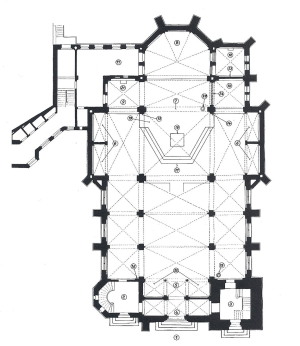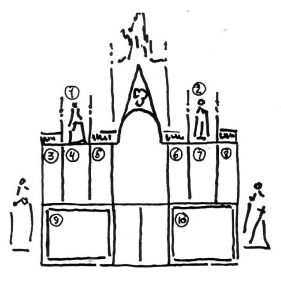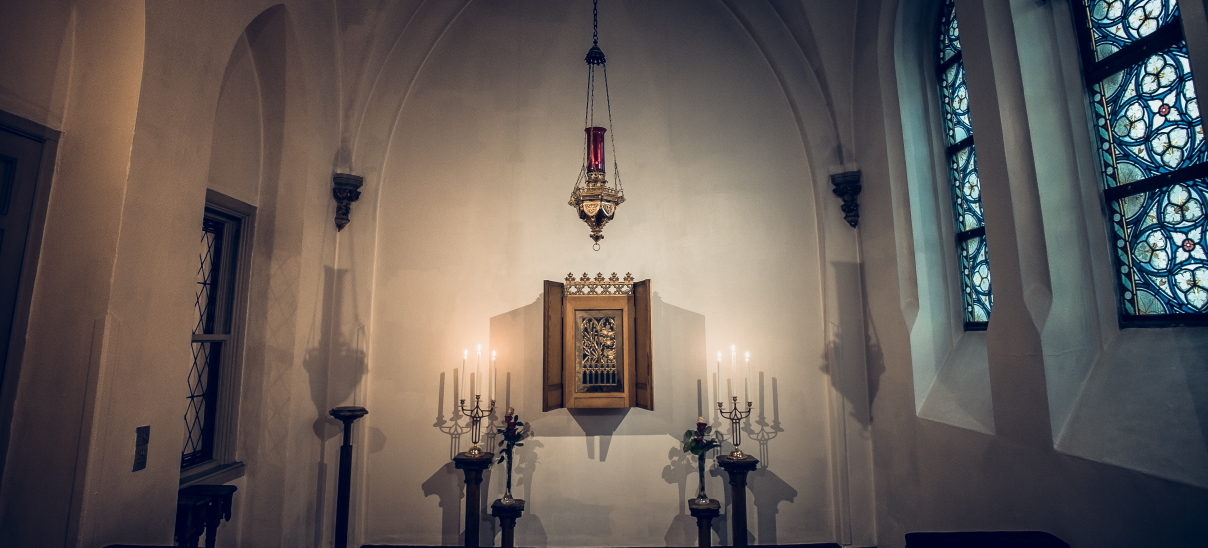 ‘ A different church ‘
‘ A different church ‘
The picture shows an architectural drawing of the concrete changes in the church room, introduced by the large-scale refurbishment in 1972.
The changes were the result of the Second Vatican, which, inter alia, made it possible for the altars to be moved to a more central position in the church rooms, so that the priest had a front against the parish when he stood at the altar. The benches could be made so that they formed a half-circle on the altar.
Click on the image to see it in large format
The tribulation of priests who had to read their own mass’ at the side altars had been brought to an end, so the altars became obsolete.
The three altars of the church and their choir benches, the pulpit, the confessions, the frames of the crossroads and many other decorations, all of which were removed. The high choir area was shifted up in the church, so from the benches that came to be in the transept could see the altar, which came to be at the centre of the intersection of the church space axes.
The new pulpit was put on the east floor. However, it had no sounding board, but the reliefs from the old pulpit were used to adorn its flanks.
In line with the second Vatikankoncils guidelines, the tabernacle from altar was placed in a separate place in a sacrament chapel.
The four-joint altarpiece from the former altar was hung in east. However in 2003, a historicerende reinterpretation of the old altar in a simplistic style was produced, so that visitors can make an idea of the original decoration dimensions.
In 2009, the old Maria altar was rebuilt according to the same principle as altar. Since the refurbishment, the chapel had only been marked by the Maria statue, and in front there was possibility to light Votiv candles.
With the help of different craftsmen, Michael Hadley-Madsen had have a coordinating role in the reborn of the two altars.
Two new confessions in the Sober style of the time – the so-called ‘ phone booths ‘ – were established at the back of the church under organ Pulpituret.
In 1972 the refurbishment was a shock to many people and to the delight of others.
It is quite interesting that recent years of reinterpretation of the church’s original furnishings have resonated with joy among many in the parish.
Structure of the altarpiece:
 Here we have presented a handmade drawing of the ‘ new ‘ reproducing of the old altar in the church from 1905, which was taken down in conjunction with the reconstruction in 1972.
Here we have presented a handmade drawing of the ‘ new ‘ reproducing of the old altar in the church from 1905, which was taken down in conjunction with the reconstruction in 1972.
Many individual details from the altar, statues, reliefs, wood carving, crafted in stone and stair steps can we only imagined today. However, several of these parts have survived the decisive changes.
They are today in depot waiting to be used.
Click on the image to see it in large format
Who is who on the altar? All the pictures on the enclosed altarpiece tell of Eucharist (Holy Supper).
- St. Ignatius of Loyola (1491 – 1556). Founder of Jesuit order.
He and seven brothers made their first pledges in 1534. - St. Frans Xaver (1506-1552). One of the first seven members of Jesuit order. In 1540, Frans Xaver was sent to the Far East as a missionary. He became saint in 1622 and is the patron saint of missionaries. He is buried in Goa, India.
- King Wenceslav (d. 935) He even cultivated the wheat and the grapes to be used for the mass’.
- An angel brings the Prophet Elia’s bread and water in the desert. The story from 1. Kings Chapter 19, verse 5-8.
- St. Tarcisius lived in the 3rd Century. He was killed because he brought the Eucharist to Christian prisoners. He is the patron saint of Ministranter.
- St. Barbara, died around 240. She holds a ciborium, ie. a container for the consecrated sacramental bread, as a sign that the believers call upon her to not die without receiving communion.
- The angel stops Abraham when he wanted to sacrifice his son Isaac at the Moria Mountain (1st Leviticus Chapter 22).
- St. Clara of Assisi 1194-1253 founder of the Clarisse order. She rescued her fellow sisters in the monastery from soldiers who attacked them by holding a monstrans with the sacred ciboria up against them.
- The feeding miracle, where Jesus took five bread and two fish and made so much food that over 5000 people could get enough to eat. Matthew chap. 14, verse 15-21, Markus chap. 6 verse 34-44, Johannes chap. 6 verses 5-13.
- The wedding in Kana, where Jesus made his first miracle and changed water to wine. Johannes chap. 12, verse 1-12. The picture shows Jesus together with the Virgin Mary because it was her who asked him to do something, as there was not enough wine for all the guests.
On the left side is St. Peter, who always can be recognized with a big key in his hand. It represents the key to the Kingdom of heaven, which is a sign that Jesus told him that he should be the rock Jesus will build the church upon and that he should get the key to the Kingdom of heaven. (Matthew chap. 16, verse 15-20).
To the right is St. Paul with a sword in his hand, as a sign that he suffered martyr death by being beheaded.

